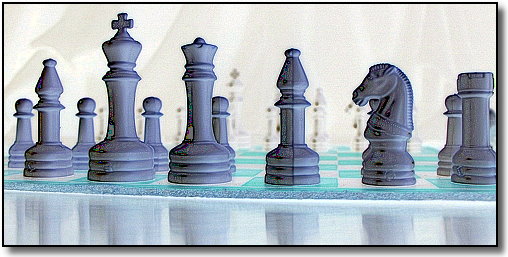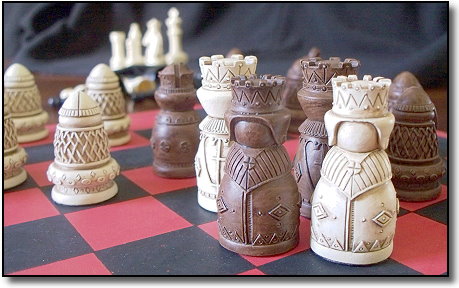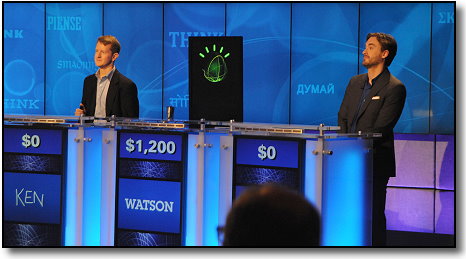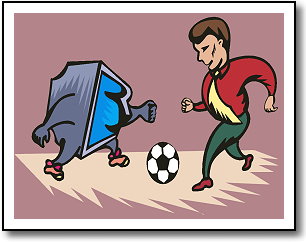 | ||||






 | ||||
|
WELCOME TO THE ESSAY ARCHIVES!
<< June
<< Part I
(June/July)
<< June
<< June
<< June
<< Part I
(June/July)
* * *
|
A Game-Changing Milestone: The Garry Kasparov-Deep Blue Chess Match and Beyond Computer capabilities are emerging today that were considered impossible one or
two decades ago. Examples include the ability to transcribe accurately normal continuous human speech, to understand and respond intelligently to natural language, to recognize patterns in medical procedures such
as electrocardiograms and blood tests with an accuracy rivaling that of human physicians, and, of course, to play chess at a world-championship level. As computers continue to gain in capacity at an
exponential rate, we will have the same experience . . . that Kasparov had in chess. Over the next several decades, machine competence will rival -- and ultimately surpass -- any particular skill one
cares to cite, including our marvelous ability to place our ideas in a broad diversity of contexts . . . The emergence in the early twenty-first century of a new form of intelligence on Earth that can compete with,
and ultimately significantly exceed, human intelligence will be a development of greater import than any of the events that have shaped human history." Ray Kurzweil in The Age of the Spiritual Machine (n1) Can machines think? Do they have, or will they ever have "intelligence?" And what does the game of chess have to do with the subject? Chess is sometimes referred to as the "game of kings," and true mastery of the game generally is considered to be a highly intellectual human pursuit. The 1997 chess match between then world champion Garry Kasparov and the IBM computer Deep Blue was a milestone event, but as the quote above indicates, is it an experience we can all expect to have in the future? And what is the "experience" to which the quote refers? The story began long before the 1997 match took place, and ongoing developments continue today. Computers and Chess Artificial intelligence, or AI, is "a field of computer science that seeks to understand and implement computer-based technology that can simulate characteristics of human intelligence. A common goal of artificial intelligence work involves developing computer programs capable of learning from experience in order to solve problems." (n2) Work on artificial intelligence began in the 1950s, and the term was coined in 1956. (n3) Two pioneers in the field of computing, Alan Turing of the University of Manchester in England, and Claude Shannon of MIT, first proposed the idea of chess-playing computers after World War II and in the 1950s. In his 1950 Philosophical Magazine article entitled "Programming a Computer to Play Chess," Shannon suggested computers could be capable of playing chess, and while that might be "of no practical importance," that perhaps it would be useful in "attacking other problems of a similar nature and greater significance." (n4) But of all games, why chess? In genetics, the common fruitfly, drosophilia melanogaster, is considered an excellent subject for the study of broader genetic questions. The fruit flies "are prolific breeders; a single mating will produce hundreds of offspring, and a new generation can be bred every two weeks." (n5) Chess is sometimes referred to as the "drosophilia" of games, and it has been considered valuable for lessons which can be applied to both the study of artificial intelligence and real-world applications. The characteristics of the game that make it well-suited for machine play are that "it is a game that pits one mind against another. There is no luck as in backgammon, no guessing of hidden information as in blackjack, [and] only a single opponent . . . [It is also] one of the few intellectual games where a fairly accurate performance measure exists. All strong chess players in the world have ratings. Just as auto engines are measured in horsepower, computers in mips and battleships in firepower, the best chess players are all given a numerical rating based on their relative playing strength." (n6) The challenge of developing a computer that could beat a world chess champion grew, and along the way it became something akin to the holy grail of AI at the time. The problem and challenge attracted some of the best minds in computer science, and work was conducted at some of the nation's top universities and research laboratories. Two organizations, the ACM (Association for Computing Machinery, www.acm.org) and the ICCA (International Computer Chess Association, now the International Computer Games Association, http://ilk.uvt.nl/icga), were also "major catalytic forces in the field of computer chess . . . holding major competitions and [having] published many of the most important papers on the subject." (n7) Though in the 1950s many scientists thought "that chess playing was an area in which computers could make rapid headway, . . . the problem turned out to be much harder than they imagined, as did many other problems in AI." (n8) Gradual progress was made over the years from the 1960s through the 1980s, with computer programs gradually being able to play against human opponents at higher and higher levels. The company which finally produced a computer which would go on to beat a human world champion was IBM.
IBM, Deep Blue and Kasparov In 1989, "IBM hired a team of talented researchers who had just completed their Ph.D. studies at Carnegie Mellon University to design a program that would defeat the human world champion, then Garry Kasparov. When the team joined IBM, it brought along its program, Deep Thought, which was playing at a weak grandmaster level." (n9) In order to understand why the task put before the team (and other researchers) was not just to design a computer that could play chess but one that could beat a grandmaster and world champion player, it is probably necessary to understand a bit more about the rankings of chess players. It was said earlier that all strong chess players in the world have numerical ratings, and at the time of the challenge Garry Kasparov was not only the most highly-rated player in the world, but he was also considered by many to be the best chess player who had ever lived. His rating was "approximately 2820, the only player ever to exceed 2800. Fewer than 10 players in the world [were then] rated over 2700. The approximately 200 players rated over 2600 are typically grandmasters. Masters, ranked over approximately 2200, constitute the next category, with several thousand players in this group . . . [and] someone with a good head and a year of experience would likely be rated about 1400." (n10) You can read more about Kasparov at www.research.ibm.com/deepblue/meet/html/d.1.shtml, and his personal website is www.kasparov.com. The first match between Deep Blue, a 32-node IBM RS/6000 SP high performance computer with "several hundred special-purpose chess chips running in tandem" (n11) and Kasparov took place in February of 1996 in Philadelphia at the Philadelphia ACM Chess Challenge. In a public statement prior to the match, Kasparov predicted that "In serious classical chess, computers do not have a chance in this century." (n12) The six-game match was played over a week-long period, and in the end Kasparov won 4-2 (in computer chess scoring, a win is worth one point and a draw worth one-half a point to each competitor. Kasparov lost the first game and won the second, fifth and sixth games; Deep Blue won the first game and the third and fourth games were draws). It seemed that Kasparov's statement would hold, at least for the time being. A rematch was set for May of 1997, and the IBM scientists went to work improving Deep Blue. What began as "an effort to explore how to use parallel processing [many processors working together simultaneously] to solve computing problems" ended up becoming "what is . . . widely considered to be the greatest chess-playing computer ever constructed." (n13) In the year between the 1996 Philadelphia match and the 1997 rematch, the IBM scientists improved both Deep Blue's speed and its chess knowledge. In 1996 Deep Blue could search "an average of 100 million [chess] positions per second," (n14) but the 1997 Deep Blue doubled that speed and was able to search 200 million positions per second (compared to 2 - 3 for Kasparov). (n15) The scientists also increased Deep Blue's chess "knowledge" by using chess grandmasters to help in programming the system. IBM still maintains the site with information concerning Deep Blue's team and more technical information about the computer. If you'd like to explore the information in greater depth, visit the following pages: - For all materials, go to www.research.ibm.com/deepblue As May arrived, articles began to appear in the popular press in anticipation of the match. Several took the tone of a Newsweek article which presented the rematch as "Man vs. Machine," with the subtitle "When Garry Kasparov takes on Deep Blue, he'll be fighting for all of us. Whose side are you on?" (n16) The match took place in midtown Manhattan, and Deep Blue was the ultimate victor. Kasparov won only the first game, with draws in games three, four and five, and with Deep Blue winning the second and final games. The most controversial play of the match came in the second game. "On Move 36, Blue had an opportunity to shift its queen to a devastating position -- clearly a smart choice. Instead it took a subtler but superior tack that wound up to be near decisive in defeating Kasparov." (n17) The move was so successful (yet unanticipated) that it caused Kasparov to say that "suddenly [Deep Blue] played like a god for one moment," (n18) and the move made it evident that a "computer was playing better chess than any machine ever had before." (n19) The match ended in the final game "after only 19 moves and less than an hour of play." (n20) With that, as one of Deep Blue's developers said in a later book "almost 50 years after Claude Shannon made the proposal on how to program a computer to play chess, the quest for the holy grail was finally over." (n21)
Man vs. Machine: The Aftermath In a post-match review article, Yale University computer science professor David Gelernter said of Deep Blue that "Deep Blue is a beautiful and amazing technological achievement. It is an intellectual milestone, and its chief meaning is this: that human beings are champion machine builders. All sorts of activities that we thought could be done only by minds can in fact be done by machines, too, if the machine builders are smart enough . . . [But in the end] it plays the game for the same reason a calculator adds or a toaster toasts: because it is a machine designed for that purpose." (n22) Part of the reason that Deep Blue was able to score its victory was due to the rapid increases in computing power, speed and memory since the notion of a chess-playing computer was first proposed in the 1950s. In 1958 a chess program "running on an IBM 704 searched five chess positions per second; in 1997 Deep Blue searched 200 million chess positions per second, a 40 million-fold increase . . . [Also], Deep Blue used one gigabyte of random access memory in each of its 30 computers, for a total of 30 gigabytes or 240 billion bits. This high-speed memory compares with approximately 4000 36-bit words -- 144,000 bits -- on an IBM 704, an increase by a factor of approximately 17 million." (n23) Though these numbers may be astounding, they still represent only about one percent of the processing capability of the human brain. (n24) If trends in the growth of computer processing speed and memory continue, however, some estimate that computers could achieve the memory capacity and computing speed of the human brain by around the year 2020. (n25) So if a human and a computer can play chess at the same level, does it necessarily follow that they approach the game in the same way? Are they both "thinking" about the moves being made? IBM characterized the difference between the two opponents as "dissimilar processes yield[ing] similar conclusions" (n26) and illustrated the differences between human and machine by putting together a "top ten" list of dissimilarities between the ways they play chess. The full "Top Ten" list is part of the IBM Research Deep Blue web site and can be accessed, along with related information, at www.research.ibm.com/deepblue/meet/html/d.2.shtml. The list is summarized here as follows: 1. Deep Blue can examine and evaluate up to 200,000 chess positions per second; Kasparov up to three positions per
second. One author refers to the need to use large parallel systems to rapidly search through voluminous data (such as the 200 million positions per second suggested in No. 10) as a "brute force" approach to AI. While on one hand Deep Blue's defeat of Kasparov was the reaching of the "holy grail" of AI at the time, the author also calls it "the end of an era, the era of the 'quick kill' where hardware and brute force solve interesting problems" (n28). He also says of chess that "it is the last problem in traditional AI that will . . . be solvable by 'simple' brute force techniques," (n29) and that "for nearly all realistic AI problems [e.g. natural language understanding, scene analysis, speech recognition, etc.] the brute force methods in Deep Blue are hopelessly inadequate." (n30) The 2011 Challenge - Human vs. Machine in Jeopardy! More so than inadequate, the system which powered Deep Blue might be considered incomplete, a first step forward in AI at a time when changes in computer technology were continuing at a rapid pace. Consider the "top ten" list from the Deep Blue-Kasparov rematch (above) in the context of the following quote: "A computer system that can directly and precisely answer natural language questions over an open and broad range of knowledge has been envisioned by scientists and writers since the advent of computers themselves. Consider, for example, the "Computer" in Star Trek. Taken to its ultimate form, broad and accurate open-domain question answering may well represent a crowning achievement for the field of Artificial Intelligence (AI). While current computers can store and deliver a wealth of digital content created by humans, they are unable to operate over it in human terms. The quest for building a computer system that can do open-domain Question Answering [QA] is ultimately driven by a broader vision that sees computers operating more effectively in human terms rather than strictly computer terms. They should function in ways that understand complex information requirements, as people would express them, for example, in natural language questions or interactive dialogs. Computers should deliver precise, meaningful responses and synthesize, integrate and rapidly reason over the breadth of human knowledge as it is most rapidly and naturally produced -- in natural language text." (n31)
Watson Avatar photo source: IBM Press Room Press Release/Photo this challenge, a research team from IBM's Deep QA project, led by principal investigator David Ferrucci, created "Watson" (named after the founder of IBM), an artificial intelligence computer system capable of answering questions posed in natural language. [Materials concerning Watson can be accessed by starting at www-03.ibm.com/innovation/us/watson.] Watson's debut on Jeopardy! took place this year and will be discussed below, followed by information on the technology behind the computer system. Watson Competes - and Wins On February 14, 15 and 16 of this year, IBM's Watson competed against two of Jeopardy's best-known champions: all-time highest money winner Brad Rutter, and Ken Jennings, the former contestant with the longest winning streak. Watson's avatar, or the "face" for the computer's stage "persona," is included above. The avatar was wired to inputs like Watson's level of processing - changing color, for example, to indicate its confidence in a response or whether it answered a question correctly or incorrectly (n33). A picture of the three contestants in a practice match is also included below. As with its human competitors, Watson was not allowed any wireless, Ethernet, internet or other outside connections, and it received its clues electronically at exactly the same time as the human players saw them. Watson was also required to use the same hand buzzer as the other contestants to buzz in and answer the questions, though Watson was wired with a mechanical device to push the button. The Jeopardy! challenge was televised, and Watson ended up winning the contest and the one million dollar prize, which IBM donated to charity. A search of "Watson" and "Jeopardy" on You Tube will pull up a variety of videos from snippets and background to the full games of the Watson/Jeopardy! match. ;So what exactly is Watson, and how did the computer win? In techno-speak, Watson is a system based on IBM's DeepQA architecture running on a cluster of IBM Power7 processor-based servers. "Each of Watson's 90 clustered IBM Power 750 servers features 32 Power 7 cores running at 3.55 GHz. Running the Linux operating system, the servers are housed in 10 racks along with associated I/O nodes and communication hubs. The system has a combined total of 16 terabytes of memory and can operate at over 80 teraflops (trillions of operations per second)." (n34) According to IBM figures, Watson is over 100 times more powerful than Deep Blue was. To view an interactive schematic of Watson's structure and see details of how the computer answered the Jeopardy! questions, go to www-03.ibm.com/innovation/us/watson/watson-for-a-smarter-planet/watson-schematic.html. (Please note: there may be a problem viewing this with some Explorer browsers, but not with Firefox.)
IBM's Watson computer system competes against Jeopardy's two most successful and celebrated contestants, Ken Jennings (left) and Brad Rutter (right), in a practice match held during a press conference at IBM's Watson Research Center in Yorktown Heights, New York, in January of this year. The televised Jeopardy! tournament was held on February 14, 15 and 16. Source: IBM Press Room Press Release/Photo. At the heart of Watson, and IBM's DeepQA, is still what the author in the previous section on chess called the "brute force" of massive parallelism, or the large number of servers clustered together and linked via a super high-speed network. One "hotpoint" on the Watson schematic (mentioned in the previous paragraph) indicates that Watson's computing power would be the equivalent of over 2,800 separate computers each with a single processor. In addition to the power of the parallel system, several other engineering and software features played significant roles in Watson's success. One of the most important of these was Apapche UIMA, "a standard framework for building applications that perform deep analysis on unstructured content, including natural language text, speech, images and video (n35). On a single processor, Watson required two hours to answer a question. UIMA-AS was the "principal structure for assembling, scaling-out [over all processors] and deploying its analytic content" (n36), allowing Watson to deliver answers in 1 - 6 seconds. Another significant difference between Deep Blue and Watson was in the task each was constructed to perform. Deep Blue searched for chess moves among possible moves in the confined space of a chess board. Watson, on the other hand, was tasked "to do what was once considered the exlusive domain or human intelligence: rapidly answer and rationalize open-domain natural language questions confidently, quickly and accurately . . . [while operating] in the nearly limitless, ambiguous and highly contextual domain of human language and knowledge. Watson [was also] tasked to understand and answer human questions and to know when it [did] and [didn't] know the answer - to assess its own knowledge and ability - something humans find relatively easy." (n37) This was accomplished through what IBM referred to as "pervasive confidence estimation." (n38) The Watson system contained "roughly 200 million pages of natural language content (equivalent to reading one million books)." (n39) Once a clue had been revealed, Watson's search for an answer began. Based on the computer's interpretation of the question and the data located, Watson's top three responses to each clue were displayed on the answer panel along with the confidence level for each answer. If the top response exceeded the confidence threshold, Watson buzzed in to answer. The accomplishments of Watson are not considered the attaining of a "holy grail" or an end-point in an area of AI, but rather an indication of what might be accomplished in the days ahead. Stephen Baker, who wrote a book chronicling the Watson's development and the Jeopardy! match, says that "despite Watson's virtuosity with the buzzer and its remarkable performance on Jeopardy! clues, the machine's education is far from complete. As this technology expands from its quiz-show roots into the rest of our lives, engineers at IBM and elsewhere must sharpen its understanding of contextual language. And they will . . . Watson represents merely a step in the development of smart machines. Its answering prowess, so formidable on a winter afternoon in 2011, will no doubt seem quaint in a surprisingly short time." (n40) Ongoing developments in the field of AI, though beyond the scope of this essay, are changing rapidly. Take the original challenge of the chess-playing computer. "Garry Kasparov . . . recently wrote that the golden age of man-machine battles in chess lasted from 1994 to 2004. Before that decade, machines were too dumb; after it, the roles were reversed." (n41) One of the fields in which AI is having tremendous impact, however, is in robotics. If "brains" and intelligence were part of the original AI challenges, could "brawn" and physical challenges be far behind? If the the founders and participants of the leagues of soccer-playing robots are correct, the next great man vs machine match-up may be with robots against World Cup champions. Soccer-Playing Robots and RoboCup
* * * The following quote from the James McManus book "Cowboys Full: The Story of Poker" appears in the introduction to the theme for this summer's site: " . . .at the higher symbolic level on which most modern humans also operate, cerebral games like chess, bridge, poker, Scrabble, and what we call trading or handicapping -- betting on the performance of horses, humans, corporations, or currencies -- mimic what scouts, hunting-party leaders, and tribal chiefs used to do and, nowadays, what captains, coaches, CEOs, generals and presidents do. While our physical and mental skill sets are both still evolving, our competitive urge probably feels much the same as it did twelve thousand years ago on the Colorado plateau or Kenyan savanna." (n44) In this day and age, it appears that not only the human but also the "physical" and "mental" skill sets of machines are evolving -- with the pace of machine development often outpacing that of humans. Whether or not that will lead to the outcome as predicted in the quote at the top of the page is not known. What is even more interesting, perhaps, is that the progress continues to be made in what is considered a widely popular format: that of challenges within the context of games. FOOTNOTES - The following are the footnotes indicated in the text in parentheses with the letter "n" and a number. If you click the asterisk at the end of the footnote, it will take you back to the paragraph where you left off. n1 - Kurzweil, Ray, The Age of the Spiritual Machine. New York: Viking/Penguin 1999, pp. 4-5 (*) n2 - Smith, Raoul, The Facts on File Dictionary of Artificial Intelligence. New York: Facts on File 1989, p. 13. (*) n3 - Munakata, Shinori, Fundamentals of the New Artificial Intelligence: Beyond Traditional Paradigms. New York: Springer-Verlag 1998, p. 1. (*) n4 - Shannon, Claude, "Programming a Computer to Play Chess," Philosophical Magazine, Vol. 41, Issue 314, 1950, p. 256. (*) n5 - Campbell, Neil A., Biology, 3rd Edition. Redwood City, CA: The Benjamin/Cummings Publishing Company, Inc. 1993, p. 282. (*) n6 - Newborn, Monty, Deep Blue: An Artificial Intelligence Milestone. New York: Springer-Verlag 2003, pp. 4-5. (*) n7 - Newborn, Monty, Kasparov vs. Deep Blue: Computer Chess Comes of Age. New York: Springer-Verlag, 1997, foreward. (*) n8 - Gelernter, David, "How Hard is Chess?" Time, Vol. 149, No. 20, May 19, 1997, p. 73. (*) n9 - Newborn, Monty, Deep Blue, p. 12. (*) n11 - Cipra, Barry, "Will a Computer Checkmate a Chess Champion at Last?" Science, Vol. 271, 2 February 1996, p. 599. (*) n13 - IBM Research, "Deep Blue: This 1.4 Ton 8-year-old Sure Plays a Mean Game of Chess," available online at www.research.ibm.com/deepblue/meet/html/d.3.shtml, viewed July 2011. (*) n14 - Cipra, Barry. "Will a Computer Checkmate a Chess Champion at Last?" Science, vol. 271, 2 February 1996, p. 599. (*) n15 - IBM Research, "Deep Blue." (*) n16 - Levy, Steven, with Powell, Bill and Stone, Brad, "Man vs. Machine," Newsweek, May 5, 1997, p. 51. (*) n17 - Levy, Steve, "Big Blue's Hand of God," Newsweek, May 19, 1997, p. 72. (*) n19 - Gelernter, Time, p. 72. (*) n20 - Newborn, Monty, Deep Blue, p. 211. (*) n21 - Feng-Hsiung, Hsu, Behind Deep Blue: Building the Computer that Defeated the World Chess Champion. Princeton/Oxford: Princeton University Press 2002. (*) n22 - Gelernter, Time, p. 72. (*) n23 - Newborn, Monty, Deep Blue: AI Milestone, p. 226. (*) n25 - Kurzweil, The Age of the Spiritual Machine, p. 3. (*) n26 - IBM Research, "Kasparov vs. Deep Blue: A Contrast in Styles." Viewed online at IBM Deep Blue web site, www.research.ibm.com/deepblue/meet/html/d.2.shtml, July 2011. (*) n28 - Stork, David G. "Hal, Deep Blue and Kasparov: The End of an Era, The Beginning of Another?," viewed online at IBM Deep Blue website at www.research.ibm.com/deepblue/learn/html/e.8.1.shtml in July 2011, p. 5 of 6. (*) n31 - IBM DeepQA Project information. Viewed online July 2011 at www.research.ibm.com/deepqa/deepqa.shtml. (*) n32 - IBM Systems and Technology, Watson - A System Designed for Answers, IBM White Paper. Somers, New York: IBM, February 2011, p. 3. Available online (after completing short registration form) at www.14.software.ibm.com/webapp/iwm/web/signup.do?source=stg-600BE30W. (*) n35 - IBM DeepQA/Watson FAQs, viewed online July 2011 at www.research.ibm.com/deepqa/faq.shtml. (*) n36 - IBM Sytems and Technology Watson White Paper, p. 4. (*) n37 - IBM DeepQA/Watson FAQs, viewed online July 2011 at www.research.ibm.com/deepqa/faq.shtml. (*) n38 - IBM Sytems and Technology Watson White Paper, p. 4. (*) n39 - IBM DeepQA/Watson FAQs, viewed online July 2011 at www.research.ibm.com/deepqa/faq.shtml. (*) n40 - Baker, Stephen, Final Jeopardy: Man vs. Machine and the Quest to Know Everything. Boston and New York: Houghton Mifflin Harcourt 2011, p. 254. (*) n42 - "A Brief History of RoboCup," viewed online July 2011 at www.robocup.org. (*) n43 - RoboCup "Objective," viewed online July 2011 at www.robocup.org. (*) n44 - McManus, James, Cowboys Full: The Story of Poker, New York: Farrar, Straus and Giroux 2009, p. 25. (*) LINKS INCLUDED IN ESSAY - The following are links included in the essay.
BIBLIOGRAPHY - The following is the Bibliography for the July 2011 essay. "A Brief History of RoboCup," viewed online July 2011 at www.robocup.org. Baker, Stephen, Final Jeopardy: Man vs. Machine and the Quest to Know Everything. Boston and New York: Houghton Mifflin Harcourt, 2011 Campbell, Neil A. Biology, 3rd Edition. Redwood City, CA: The Benjamin/Cummings Publishing Company, Inc., 1993 Cipra, Barry. "Will a Computer Checkmate a Chess Champion at Last?" Science, vol. 271, 2 February 1996, p. 599 Feng-Hsiung, Hsu. Behind Deep Blue: Building the Computer that Defeated the World Chess Champion. Princeton/Oxford: Princeton University Press, 2002 Gelernter, David. "How Hard is Chess?" Time, Vol. 149, No. 20, May 19, 1997, pp. 72 - 73 IBM DeepQA Project information. Viewed online July 2011 at www.research.ibm.com/deepqa/deepqa.shtml. IBM DeepQA/Watson FAQs, viewed online July 2011 at www.research.ibm.com/deepqa/faq.shtml. IBM Research, "Deep Blue: This 1.4 Ton 8-year-old Sure Plays a Mean Game of Chess," available online at www.research.ibm.com/deepblue/meet/html/d.3.shtml, viewed July 2011. IBM Research, "Kasparov vs. Deep Blue: A Contrast in Styles." Viewed online at IBM Deep Blue web site, www.research.ibm.com/deepblue/meet/html/d.2.shtml, July 2011 IBM Systems and Technology, Watson - A System Designed for Answers, IBM White Paper. Somers, New York: IBM, February 2011, p. 3. Available online (after completing short registration form) at www.14.software.ibm.com/webapp/iwm/web/signup.do?source=stg-600BE30W. Irvine, James H., and Schwarzbach, Sandra, "The Top 20 (Plus 5) Technologies for the World Ahead," The Futurist, Vol. 45, No. 3, May-June 2011, pp. 16 - 24 Kurzweil, Ray. The Age of the Spiritual Machine. New York: Viking/Penguin, 1999 Levy, Steve, "Big Blue's Hand of God," Newsweek, May 19, 1997, p. 72 Levy, Steven, with Powell, Bill and Stone, Brad, "Man vs. Machine," Newsweek, May 5, 1997, pp. 50 - 56. Marsland, T. Anthony, and Schaeffer, Jonathan, eds. Computers, Chess and Cognition, New York: Springer-Verlag, 1990 McManus, James. Cowboys Full: The Story of Poker, New York: Farrar, Straus and Giroux, 2009 Munakata, Shinori. Fundamentals of the New Artificial Intelligence: Beyond Traditional Paradigms. New York: Springer-Verlag, 1998 Newborn, Monty. Deep Blue: An Artificial Intelligence Milestone. New York: Springer-Verlag, 2003 Newborn, Monty. Kasparov vs. Deep Blue: Computer Chess Comes of Age. New York: Springer-Verlag, 1997 RoboCup "Objective," viewed online July 2011 at www.robocup.org. Schaeffer, Jonathan, et al., "Checkers is Solved," Science, Vol. 317, 14 September 2007, pp. 1518 - 1522 Shannon, Claude, "Programming a Computer to Play Chess," Philosophical Magazine, Vol. 41, Issue 314, 1950, pp. 256 - 275 Smith, Raoul. The Facts on File Dictionary of Artificial Intelligence. New York: Facts on File, 1989 Stork, David G. "Hal, Deep Blue and Kasparov: The End of an Era, The Beginning of Another?," viewed online at IBM Deep Blue website at www.research.ibm.com/deepblue/learn/html/e.8.1.shtml in July 2011
To return to the top of the page, click here. To return to the essay archives, click here. Follow www.dorothyswebsite.org on TWITTER! Home | Poetry | Essays |
Free Concerts | Links | 2012 Extras |
About the Site |
|||
 | ||||
|
www.dorothyswebsite.org © 2003 - 2012 Dorothy A. Birsic. All rights reserved. Comments? Questions? Send an e-mail to: information@dorothyswebsite.org | ||||







 The
The